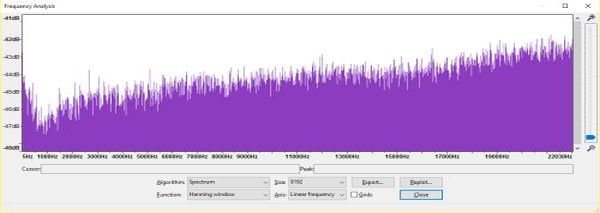Audio: phasing (0:03)

phasing plays phase shifted white noise. The centre frequency is modulated in a U-shape from 10,000Hz to 100Hz and back again to 10,000Hz using a series of eight first order allpass filters and the wet:dry mix is 50:50. The phasing figure shows the spectrogram.
Phasing, or phase shifting, is a technique to modulate phase using allpass filtering.
An allpass filter passes all frequencies and filters phase.
Phasing requires two sound inputs. The first input is an unprocessed sound, this is the dry version. The second input, the wet version, is an allpass filtered copy of the dry sound. To get the unusual phaser swishing effect, the amount of phase shift in the wet version is slowly changed up and down using a Low Frequency Oscillator. Mixing the wet and dry sounds together results in phasing.
Phasing produces a hollow metallic swishing sound:
Allpass filtering is a tricky concept. There is a cutoff frequency in allpass filtering. Usually it is 1kHz, although it can be changed. At the cutoff frequency there is no phase shift and the sound remains unchanged. The allpass filter gradually shifts the phase of frequencies below the centre frequency backwards, and advances those above the centre frequency. A first order allpass filter produces 180 degrees of phase shift, second order produces 360 degrees of phase shift, and so on. The number of filters and the order of the filter determines the number of peaks and troughs in the spectrum of the output. For example, a series of 8 first order filters produces four peaks. A typical phaser uses a series of 4-16 allpass filters.
A shift in phase is equivalent to a delay in time. Consequently, allpass filtering can be looked at as either a phase effect or as a delay effect. It is treated here as a phase effect because a time delay is the consequence of a phase shift and not the cause of it.